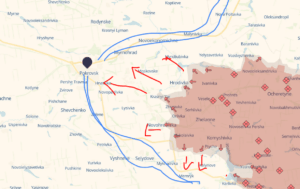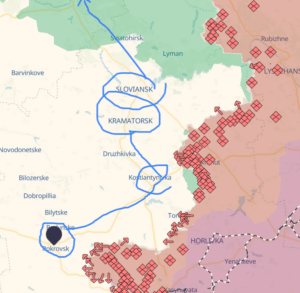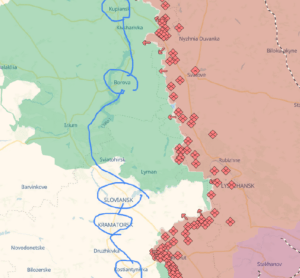Making sense of Kursk and Pokrovsk...
Ever since The Corners begin (first in, unfortunately aborted, magazine hard-copy and then later to the (equally unfortunately) far more limited blog form, the war in Ukraine has superseded original intentions, as the reality is that it simply cannot be ignored.
Which means that I receive questions now almost daily, often in the form of private mails or messages, wondering about updates (which, depending on my day—and night—job as an investigator) are delivered in somewhat haphazard fashion.
But the one question that arrives in my box numerous times a week is: “Who is winning?”
That is a huge and very debatable question. Ukraine has been pummeled for two years. A wide swath of men of fighting age (and older) are dead, injured… or they have actually fled the country. Infrastructure has been hit again and again. The population has endured destruction on a scale tantamount to that seen in the Second World War—as well as widespread atrocities that somehow get dust-binned into a few isolated locations, such as Bucha, which is disingenuous at best.
Which means Ukraine has lost… much. But then again, it has still not lost the war.
A war which is fighting on behalf of Europe, and yes, the US and that more and more vague notion of “the democratic West.”
Then there is Russia, which—if you are the dictator Vladimir Putin—has accomplished goals that possibly even he had thought previously unattainable. For Putin has managed to eliminate all democratic resistance (the death of Alexei Navalny putting the nail in the coffin for potentially decades to come). Likewise, Putin has purged the military, effectively ended any business oligarchy-related opposition and de facto allowed a more modern wave of younger military officers to the fore—while also in many, many respects modernizing on-the-ground tactics that in the past had relied almost solely on either special forces operations or, somewhat paradoxically, old-school, Second-World War roll-outs backed by overwhelming numbers and old-fashioned artillery barrages.
(And yes—I know that this sounds somewhat controversial, but more on that in a moment.)
But this is not winning, and it is very doubtful now that it will culminate in a win when total losses, including skilled personnel are factored into an economy that (despite the propaganda) has been equally debilitated and twisted into a machine that can only serve war.
The here and now…
If we choose to focus on the here and now (which is actually what most questioners are getting at) and ignore the overall and long-term debate, we are talking about two primary theaters: Pokrovsk and Kursk.
Let’s first talk about Kursk. If there is any proof that this war is a losing game for Russia, look no further. Kursk is symbolic in more ways than one. The Russian Kursk counteroffensive was the final and ultimate turning point during the Second World War, also proving at the time that Russian troops actually could conduct large and successful offensive operations in modern warfare. In short, Kursk is Russia. Russia is Kursk.
And here the Russian military was indeed taken by surprise—and it has proven surprisingly inept.
Which means, without giving away details, expect droves of Russian prisoners over the next 10 days. The Ukrainians have proven mobile, flexible and fierce—and they are are eliminating bridges in key waterways and eliminating pontoon replacements even before they can be laid forth. In short, this is clearly far more than a propaganda drive, but instead it has been a well-planned, extraordinarily well thought out incursion that means to at the minimum hold territory taken. At present, possibly as much as 1,200 square kilometers.
And then there is the prisoner angle—and while this may have been brushed aside as presidential PR, the issue is very real. Ukrainians soldiers (and civilians) are languishing in Russian camps, and the abuse they suffer and have suffered is clearly tantamount to war crimes. Yet for the first time in the war Russia has made the first approaches to deal on prisoner exchanges, and for the first time said exchanges are not limited to double digits.
Which means taking Russian soldiers prisoner is a viable and true goal for the Ukrainian military. And they will continue to be successful here.
And I mean not by the hundreds, but potentially by the thousands.
A sobering reality….
But then we have Pokrovsk.
For those who have followed the (yes, somewhat sporadic) updates on The Corners, you will note that I highlighted the dangerous vulnerability of Pokrovsk back in April of this year (which was heightened by the Russian victory at Ocheteryne, following a mishandled troop rotation).
Pokrovsk was then, as it is now (although this is already being disrupted) a key logistics hub for the eastern front from Donetsk up through Svatove and arguable to Kupiansk. As a reference, note the following maps, highlighting Pokrovsk, Konstiantynivka, Kramatorsk, Sloviansk, Borova and the Kupiansk front. In short, Ukraine is at risk of a domino effect, which could mean that logistics are cut and troops will simply be forced to pull back under duress and give up vast swaths of territory, which does appear to be Putin’s goal.
The Pokrovsk front/formerly the Avdiivka front [blue lines highlighting Ukrainian logistics links]

The Pokrovsk front noting key Ukrainian logistics hugs/links to the north:

The continuation of said links through the Svatove front to Kupiansk:

Or to be more precise, the goal is to take as much land as possible over the next four weeks--and certainly prior to November where he appears to be hoping for a Donald Trump victor and a cut off of aid to Ukraine—which would force Ukraine to a weak bargaining position what would theoretically mean cessation of hostilities at the price of Ukraine relinquishing a vast amount of its own territory. Or in other words Russian “victory.” And while this will be debated by future historians, the results for Ukraine will be no short of catastrophic.
Which means that at least at this point in time—even if we focus on the very here and now—Ukraine is not winning the war. Not right now. And this goes back to three non-debatable facts:
- Putin is much more of a psychopath that the West envisioned. For while he has been humiliated at Kursk, the clear Russian reaction is to, at least for the time being… all but ignore it. While some troops have been diverted to the region, the loss of territory and troops there has in realistic terms been met with a shrug. The focus is on Pokrovsk, as that is where Putin and his generals believe they can win the war.
- On that point, the use of FABS—massive, general purpose bombs now converted to glide bombs—has demonstrated a win-at-all costs approach by Russia, which has been effective and debilitating for Ukrainian troops, but also has absolutely destroyed Ukrainian population centers, rendering them hellscapes for Russian “occupiers” in a drive that is the very definition of genocide.
- Finally, Russian meat waves are exactly that. Once again (and obviously, there is much historical precedence here), young Russian men are being sacrificed like lemmings in a fashion that could simply not be matched by the Ukrainians even if they were also criminally insane.
The above reality was brought home to Yours Truly by a soldier who has recently fought at the front. He noted the following:
“The FABS are frustrating—the Russians usually drop them in threes,” he said. “They are not accurate, but if they hit a position they absolutely destroy it.
“They also leave troops nearby with concussions—with brain trauma—and there is also the issue that Russians started using anti-personnel drones about six months ago, and this changed the game.
The soldier added that prior to the use of said drones, the Russians would typically use mortars—and when mortars came in “you could literally just run away.” This doesn’t work with drones, and this has meant more success on the Russian battlefield.
And unfortunately, another prediction written here on The Corners is also coming true, as back on July 23, I wrote that Russian forces could conceivably be beating on the door of Pokrovsk within a month.
Today is Aug. 23. And on the local level civilians in Pokrovsk and in the nearby villages are being told to get out for their own good. Now.
Light at the end of the tunnel?
But all is not yet lost. Primarily because there is likely more to Kursk than meets the eye, but also because—as hard as it is to believe—the Russian meat waves have all but run out.
First, Kursk. That counteroffensive has also come with an improved Ukrainian ability to target Russian airfields. This is impacting Russia’s ability to consistently deliver FABS (although not yet to the level hoped).
Second, is that Kursk was smart for other reasons. No matter how many troops Ukraine packs into a given position, that position can still be obliterated by FABS and then overrun by Russian meat waves who at that point simply do not need advanced military skills to claim wasteland, even if only hundreds of meters at a time. Thus, using elite forces and brigade elements in Kursk is and will pay dividends—albeit this is now a race against time.
And attrition, as third and equally, if not more, important, is that Russia is running out of men. Here there is the very real possibility that Russia has suffered far more total casualties than currently reported. Most reports place Russian casualties in the 550,000 range. This is low, perhaps far to low, and a very believable figure is closer to 850,000—950,000. And while this may be the most controversial statement in today’s blog, what is not controversial is the following:
- Russia has blown through special forces.
- Russia is now debilitated when it comes to elite, non-special forces units.
- Hardened and experienced brigades have been decimated.
- The prison system option has basically been depleted.
- The Wagners are in no shape or form the Wagners of old.
- The military is scavenging for replacements back home—attempting to entice volunteers with (relatively for Russia) huge signing bonuses, as well as payouts for families if a soldier does not return home… and it’s not working.
The above means that in four weeks the Russian offensive—even at Pokrovsk, if it can be held, will burn out and come to a stop. At that point—and even if Pokrovsk is taken—Putin will be forced to proceed with full mobilization.
And this will not go well.
And despite Russian gains, if continued military support flows to Ukraine, Russia will be forced to hold vast amounts of territory against a flexible counter-force that will still occupy Russian territory on the front at Kursk.
And this may be the first time in Putin’s history that his reign will be put at risk.
Which also means that the West—despite war fatigue, economic woes, right-wing (and left-wing) political insanity—needs to hold strong.
For in reality, the end could be near.
One can only hope.
Slava Ukrainii and God bless.
Preston Smith is a licensed investigator based in Gdansk, Poland. He can be reached at query@cddi.pl
Photo credit: Myrnohrad, just kilometers from Pokrovsk, as of Aug. 17, 2024. Photo courtesy of the National Police of Ukraine, CC BY 4.0 <https://creativecommons.org/licenses/by/4.0>, via Wikimedia Commons.
Maps courtesy of Deepstate UA.


